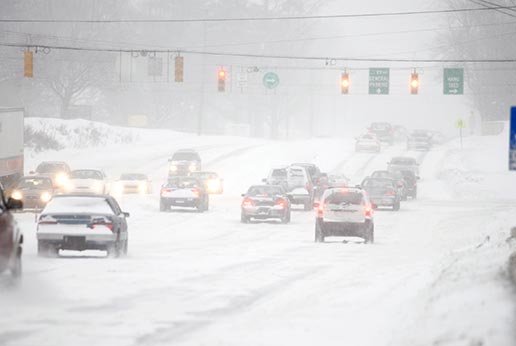Tips for Driving in the Snow

Poor driving conditions, like snowy weather, make it a challenge to be out on the road.
I Have to Drive in the Snow: Now What?
Snow tends to be best enjoyed from indoors—not out on the road. It’s best to avoid driving in the snow if you can, but if you must get behind the wheel, follow these tips to have a safe journey.
Be Prepared
The time to prep your car for snowy weather is not after it’s already been snowing. Get your car ready for harsh winter weather ahead of time, so you’re not scrambling at the last second. If you live in an area where it snows a lot, you might want to think about buying snow tires. Otherwise, you can purchase snow chains and apply them to your tires if necessary.
Another part of being prepared is having a winter emergency kit in your car. Some of the items you should include in your kit are:
- Ice scraper
- Snow shovel
- Cat litter or sand to give your car traction if you get stuck
- Flares
- Flashlight
- Booster cables
- Water
- Blankets
Keep your emergency kit in your vehicle at all times so you’re ready for anything.
Slow Down
Hopefully this one is obvious: if you’re traveling on slippery or slushy roads, you should reduce your speed. Speed limits are based on ideal conditions, and if you are driving through heavy snow, you’re not going to be able to go as fast as you would on a clear, warm day. Allow yourself more time to get to your destination if you must drive in the snow.
Increase Following Distance
In addition to slowing down, you should allow for more distance between your car and the vehicle in front of you. The normal following distance rule of 3 to 4 seconds should become 8 to 10 seconds in winter weather. This will make it easier to stop if you need to.
Use Your Headlights
When you’re driving in the snow, you should have your headlights on. This will improve your visibility and allow other drivers to see you. Just be sure that you keep your headlights clean so you are getting the most use out of them.
Don’t Slam On Your Brakes
Unfortunately, skidding and slipping are common occurrences in snowy weather, and when you find yourself losing control of your car, the natural inclination is to brake hard. But slamming on the brakes actually makes things worse: it causes your tires to lose traction, making it even more difficult for you to control the vehicle. Instead of immediately hitting the brakes, ease off the accelerator when you feel the car start to skid. This will allow the car to slow down on its own. If your car has anti-lock brakes (ABS), you should brake steadily; if you don’t have ABS, pump the brakes quickly.
Drive with Plenty of Gas
During the winter, you should always drive with at least half a tank of gas. This will prevent your gas line from freezing. It’s smart to have this much gas in the car anyway—you don’t want to get stranded somewhere in the snow! Be sure you’re fueling up regularly so you’re not taking any chances.
Want more driving tips for adverse weather? Check out our articles on Driving in the Rain and Driving in the Fog.










